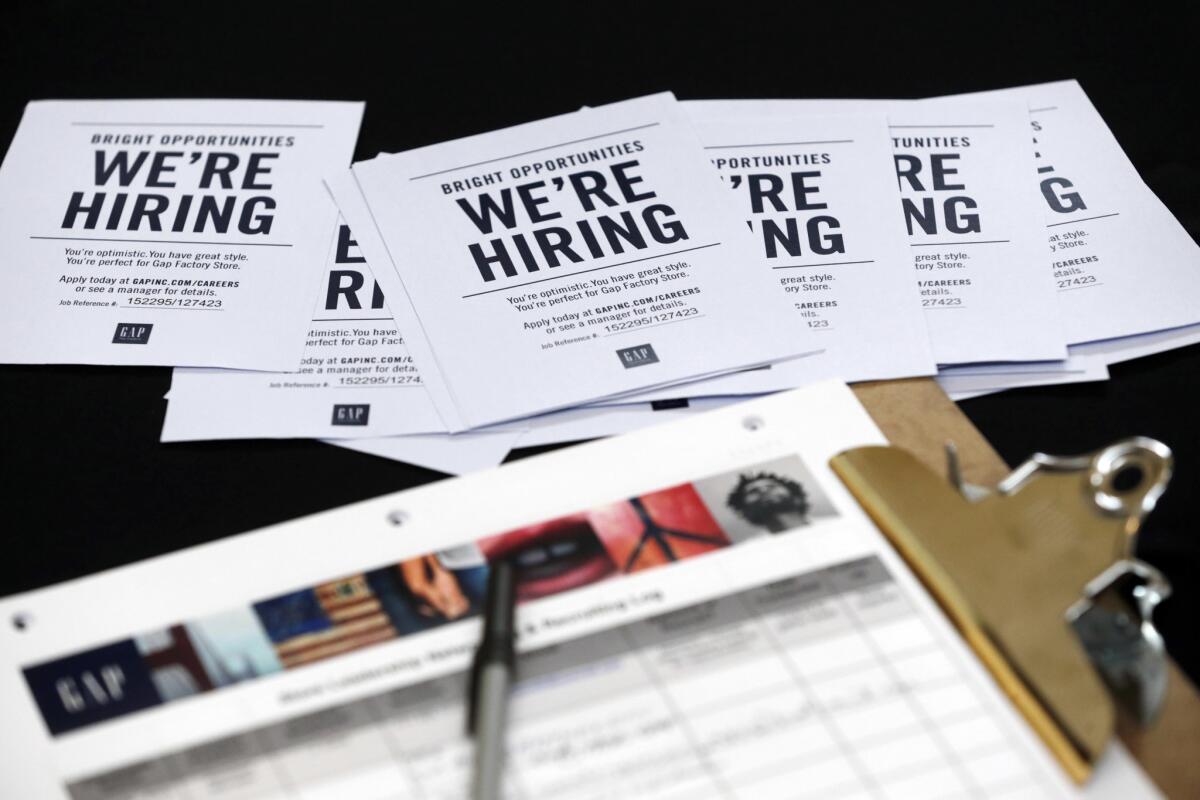U.S. unemployment falls to 50-year low even as hiring slows

- Share via
The U.S. unemployment rate fell to 3.5% in September, the lowest level in nearly five decades, even though employers appeared to turn more cautious and slowed their hiring.
The nation’s payrolls gained a modest 136,000 jobs, probably enough to ease worries that an economy weakened by the U.S.-China trade war and tepid global growth might be edging toward a potential recession. The government on Friday also revised up its estimate of job growth in July and August by a combined 45,000.
Still, a drop-off in the pace of hiring compared with last year points to rising uncertainty among employers about the job market and the economy in the face of President Trump’s numerous trade conflicts. Pay growth has also weakened, reflecting employers’ hesitance to step up wages.
“The September jobs report sent some conflicting signals, but the big picture remains one of a labor market — and an economy — whose growth is downshifting but not collapsing,” said Michael Feroli, an economist at JPMorgan Chase.
The comparatively sluggish hiring data makes it likely that this month, the Federal Reserve will cut rates for the third time this year to try to help sustain the economic expansion. At the same time, the drop in the unemployment rate from 3.7% may embolden some Fed officials who have resisted rate cuts.
The U.S. economy is “in a good place,” Fed Chairman Jerome H. Powell said Friday in remarks in Washington. “Our job is to keep it there as long as possible.”
Investors appeared pleased that the jobs report at least suggested that the economy remains resilient for now. Major U.S. stock indexes climbed.
Excluding government hiring, private-sector job gains over the last three months have slowed to an average of 119,000 a month, the weakest showing in seven years.
And despite ultra-low unemployment, average wages slipped in September, the Labor Department said. Hourly pay rose just 2.9% from the same month last year — below the 3.4% year-over-year gain earlier this year.
Julia Pollak, a labor economist at jobs marketplace ZipRecruiter, said the pay that employers are advertising has fallen this year after rising sharply in 2018. And she noted that the number of part-time workers who would prefer full-time work has risen over the last two months. Those trends “show that employers are increasingly risk-averse as global uncertainty and recession fears rise,” Pollak said.
Trump has imposed tariffs on most Chinese goods and is threatening to impose taxes on the rest of them Dec. 15, which would probably escalate prices for consumers and slow down spending.
Adding to global economic pressures, Britain is nearing an Oct. 31 deadline for a potentially chaotic exit from the European Union. And Germany appears on the brink of recession.
The weakest sector of the U.S. economy — manufacturing, which is probably already in recession — shrank by 2,000 jobs in September. At the same time, retailers shed 11,400 jobs, and employment in mining and logging was unchanged.
The big gains last month were in healthcare, which grew by 41,400 jobs, and in professional and business services, which include such higher-paying areas as engineering and accounting but also lower-paying temp work. That sector gained 34,000 positions.
Friday’s jobs data underscored the benefits of a hot job market for lower-paid Americans and traditionally disadvantaged workers. The unemployment rate for workers without high school diplomas fell to 4.8%, the lowest level on records that began in 1992. The rate for Latinos fell to 3.9%, also a record low.
Amy Glaser, senior vice president at staffing firm Adecco USA, said companies are still willing to raise pay for blue-collar workers. Some are also paying retention and signing bonuses and, in some cases, double pay for overtime.
“We’re still seeing strong demand, we’re still seeing more job opportunities out there than candidates,” Glaser said.
The employment figures carry more weight than usual because worries about the economy’s health are mounting. A measure of factory activity fell in September to its lowest level in more than a decade. And a similar gauge of the vast services sector slowed sharply in September, falling to its lowest point in three years.
Consumers are still mostly optimistic, and their spending has kept the economy afloat this year. But they may be growing more cautious. Consumer confidence dropped sharply in September, according to the Conference Board, a business research group. And consumer spending in August slowed.
More to Read
Inside the business of entertainment
The Wide Shot brings you news, analysis and insights on everything from streaming wars to production — and what it all means for the future.
You may occasionally receive promotional content from the Los Angeles Times.










